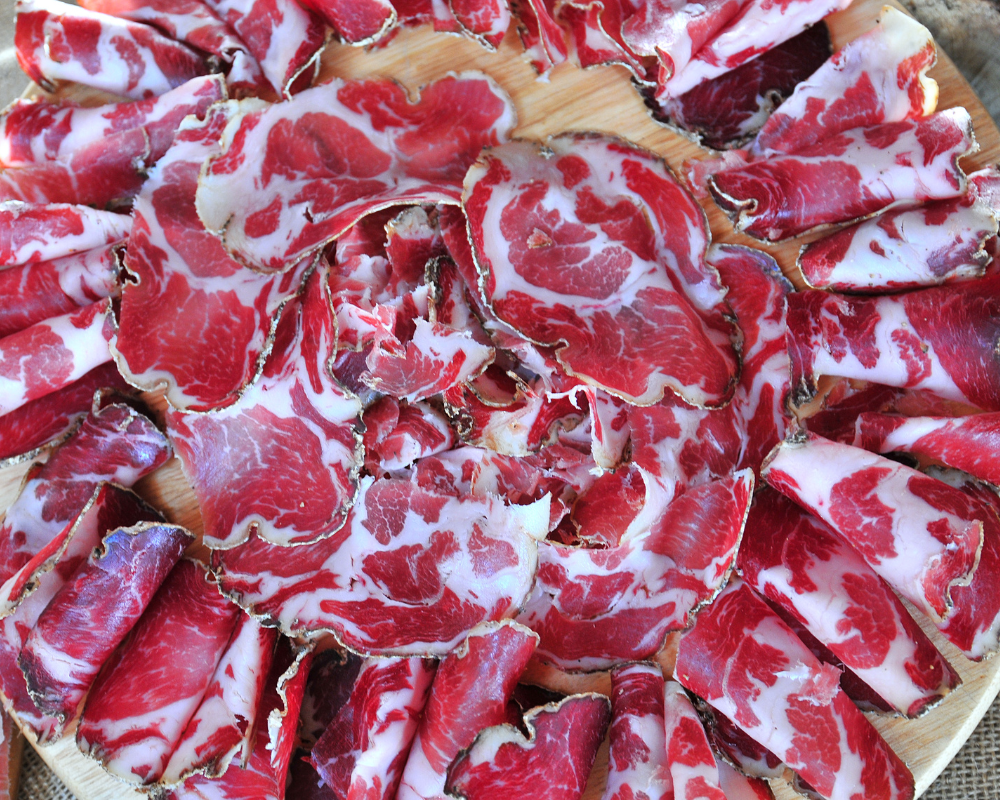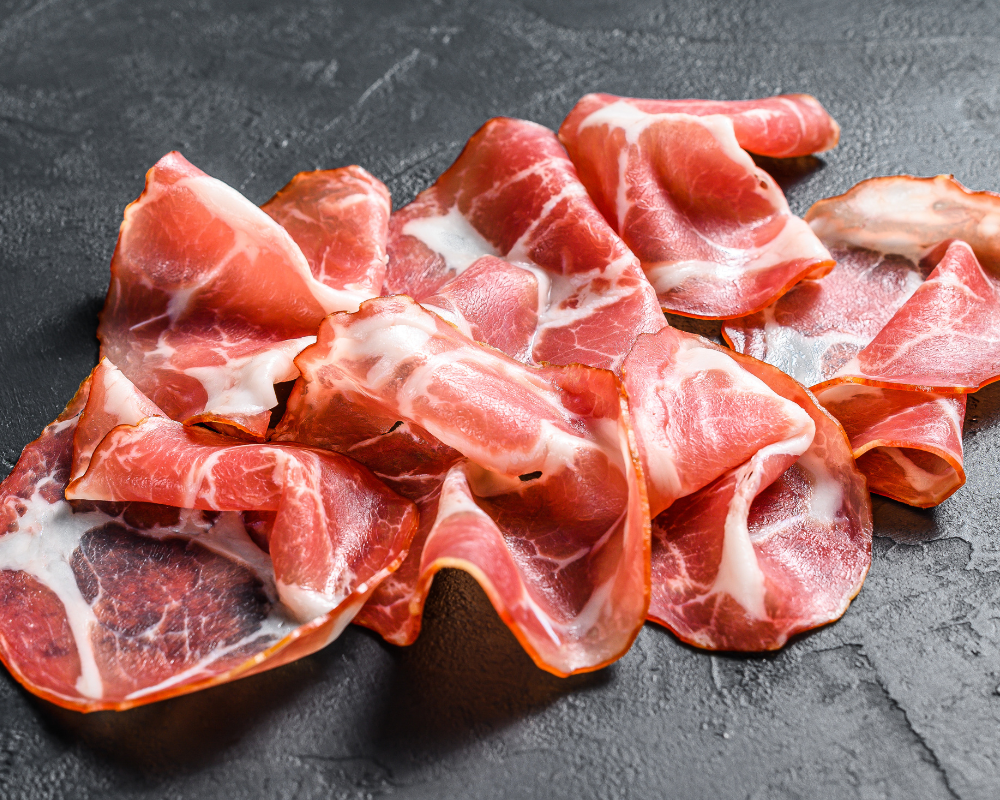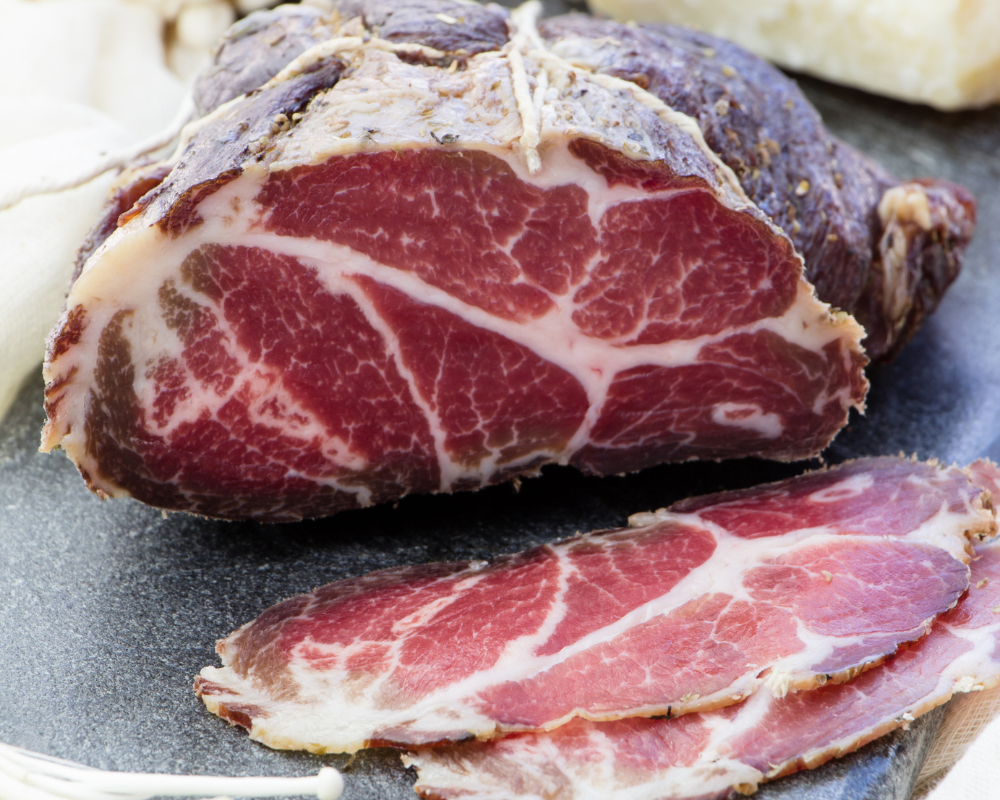Capocollo, often called capicola or coppa, is a typical pork cold cut from Italy and Switzerland. It is created from the muscle of the pig shoulder or neck that is dry-cured and runs from the neck to the fourth or fifth rib. Dry-cured and often sliced very thin, this whole-muscle salume.

Capocollo has been manufactured since the early 1800s, but historical records suggest that it may have initially appeared between the eighth and fifth centuries BC.
A cold cut of seasoned, cured, and thinly sliced pork from the neck or shoulder is known as capocollo. It is widely used in sandwiches, antipasto platters, and pasta dishes in Italian cuisine.
The distinctive flavor of capicola is frequently characterized as savory and nutty. It is a meat that may be used to spice a number of meals or relished on its own.
Capocollo is a tasty and distinctive option to think about whether you enjoy Italian food or are just trying something new.
What is Capocollo?
Capocollo is a popular Italian cured meat that is known for its rich flavor and unique texture. It is made from the pork neck or shoulder, which is seasoned with spices, herbs, and garlic before being cured for several weeks.

Once cured, the meat is typically sliced thinly and used in a variety of dishes.
Definition
Capocollo is a type of cured meat that is made from the pork neck or shoulder. It is a whole-muscle salume that is dry-cured and typically sliced very thin. The meat is seasoned with a blend of spices, herbs, and garlic, and then cured for several weeks to develop its unique flavor and texture.
Origins and Varieties
Historical records demonstrate that capocollo has been in production since the early 1800s, but its first origins may go back to somewhere between the 8th and 5th century BC. Capocollo is also known by other names such as coppa and capicola.
There are several different varieties of capocollo, which can vary in flavor and texture depending on the region in which they are produced. Some capocollo is seasoned with red pepper flakes and paprika, while others are made with wine or other seasonings.
Some capocollo is also wrapped in a natural casing, which helps to preserve the meat and give it a unique texture.
Capocollo is a delicious and versatile cured meat that can be enjoyed on its own or used in a variety of dishes. Whether you are looking to create a charcuterie board or simply want to add some flavor to your favorite recipes, capocollo is a great choice that is sure to impress.
How is Capocollo Made?
Capocollo is a traditional Italian and Swiss pork cold cut made from the dry-cured muscle running from the neck to the fourth or fifth rib of the pork shoulder or neck. Here’s how it’s made:

Curing Process
First, we start with a pork shoulder or neck. The meat is trimmed of excess fat and then rubbed with a mixture of salt, black pepper, paprika, and other spices. The meat is then placed in a natural casing and hung to dry for several weeks.
During the drying process, the meat loses moisture and develops a concentrated flavor. The temperature and humidity are carefully controlled to ensure that the meat dries evenly and doesn’t spoil.
Seasoning and Spices
The seasoning and spices used in Capocollo can vary depending on the region and the preferences of the maker. Some common herbs and spices used include garlic, red pepper, fennel, coriander, and nutmeg. Some makers also use wine in the curing process to add flavor.
The use of natural casings is also an important part of the process. Natural casings allow the meat to breathe and develop a unique flavor. The casing also helps to shape the meat and keep it from drying out too quickly.
Once the Capocollo is fully cured, it is sliced thin and served as a delicious addition to any charcuterie board. It’s a perfect pairing with a glass of red wine or a cold beer.
Capocollo is a delicious and flavorful cured meat that is a staple of Italian cuisine. The process of making Capocollo is a labor of love that requires patience, skill, and attention to detail. The result is a mouthwatering treat that is sure to please any meat lover.
Capocollo in Cuisine
Capocollo is a versatile Italian cold cut that can be used in a variety of dishes. Here are some of the most popular ways to enjoy capocollo:

Traditional Italian Dishes
Capocollo is a staple ingredient in many traditional Italian dishes. It is often used in pasta dishes, such as spaghetti alla carbonara or penne alla vodka. Capocollo can also be used as a topping for pizzas, adding a smoky and salty flavor to the dish.
Popular Sandwiches and Salads
Capocollo is a popular sandwich meat, often used in subs and paninis. It pairs well with other cured meats, such as salami or pancetta. Capocollo can also be used as a topping for salads, adding a salty and savory flavor.
One popular sandwich that features capocollo is the muffuletta, a New Orleans specialty. The sandwich is made with a round loaf of bread, filled with layers of capocollo, salami, and other meats, along with cheese and a tangy olive salad.
Varieties and Seasonings
Capocollo can be found in various regions of Italy, with different seasonings and curing methods. For example, coppa piacentina is a variety of capocollo from the Emilia-Romagna region, seasoned with black peppercorns and aged for at least six months.
In Calabria, capocollo is often seasoned with fennel seed and chili pepper, giving it a spicy kick. In Martina Franca, a town in the Puglia region, capocollo is seasoned with coriander and white wine.
Nutritional Information
Capocollo is a fatty meat, with a high sodium content. It is often air-dried or smoked, which can add to the calorie count. Capocollo is also often cured with nitrates, which can be harmful in large amounts.
Despite its high calorie and sodium content, capocollo can be enjoyed in moderation as a gourmet food or as part of an antipasto platter.
When using capocollo in recipes, it is important to use it in small portions to keep the calorie and sodium count in check.
Capocollo is a delicious and versatile Italian cold cut that can be used in a variety of dishes. Whether you prefer it thinly sliced in a sandwich or slow-roasted in a pasta dish, there are many ways to enjoy this flavorful meat.
Conclusion
In summary, capocollo is a traditional Italian and Swiss pork cold cut made from the dry-cured muscle running from the neck to the fourth or fifth rib of the pork shoulder or neck. It is a whole-muscle salume, dry cured, and typically sliced very thin.
Capocollo offers a large amount of high-quality protein and is an excellent source of B vitamins, including the crucial vitamin B12.
It is also very high in selenium, which is an essential mineral that plays a role in DNA production and enhances immune health.
Capocollo is a versatile meat that can be used in a variety of dishes, from sandwiches and salads to pizzas and pasta. It is often served as part of a charcuterie board or antipasto platter.
The taste of capocollo is savory, slightly salty, and has a rich, meaty flavor. When paired with other ingredients, it can add a unique depth of flavor to any dish.
When purchasing Capocollo, it is important to choose a high-quality product from a reputable source.
Look for capocollo that is made from high-quality pork and has been cured using traditional methods. It is also important to store capocollo properly to ensure its freshness and flavor.
Keep it refrigerated and wrapped in plastic wrap or butcher paper to prevent it from drying out.
Capocollo is a delicious and nutritious meat that is a staple of Italian cuisine. Its unique flavor and versatility make it a popular choice for chefs and home cooks alike.
Whether you’re using it as a topping for pizza or as part of a charcuterie board, capocollo is sure to add a delicious and savory flavor to any dish.







Add comment